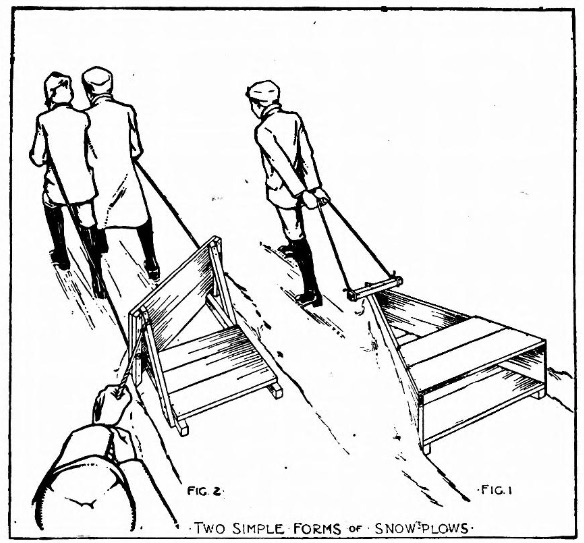
How do you like these old fashioned snow plows? The look like devices for an extreme workout club, but this is how the boys of the early 20th century plowed through sidewalks.
The article below was originally published in 1912.

How to Make a Snow Plow
Every boy who has an eye for business realizes that a snowstorm furnishes a splendid opportunity for earning money and is not slow to profit by it.
In some cities the cleaning of front walks is done with a snow plow and team of horses. This is more generally the custom in the smaller cities and suburbs, where there is much vacant property and walks that never would be shoveled if the work was left for the owners to take care of.
Such a plow, on a smaller scale, can be used to advantage by boys in removing snow from walks, and if several of you boys organize a snow shoveling brigade it will be a strong argument in your favor in soliciting contracts for the season if you promise to keep the walk plowed from street corner to street corner. The probability is that you will get more jobs in the neighborhood than you can handle. In case the main walks are plowed by the city, your plow will be handy for cleaning the inner walks, carriage drives, etc.
We designed and constructed a number of forms of small plows when boys, and these were used in the neighborhood for several winters. Two forms of these are shown in Figs. 1 and 2. You will notice that each one is of very simple construction.
The wedge-shaped plow illustrated in Fig. 1 has a base constructed as shown in Fig. 3. Make the two runners of this base out of strips about 1-1/2 inches wide and two inches thick, 36 inches long; and trim off one end of each strip so that when the opposite ends are placed 24 inches apart, as shown in Fig. 3, the trimmed ends will fit together as in Fig. 4. nail the trimmed ends together. The easiest and quickest way to put on the base covering is to allow the boards to project over the runners without any regard to the slant of the latter, and after all have been nailed in placed to saw off the ends on a line with the sides of the runners.

The sides of the plow may be made out of one-inch boards 10 or 12 inches wide. Trim the bow end of each as you did the runner ends, and overlap one on the other in the same way; then fasten them to the side edges of the base.
The two pieces of board fastened to the top edges of the sides not only form a seat, but act as braces for the sides as well. Trim off the square ends of these boards flush with the side boards, after nailing them in place. Cut a strip about 12 inches long for the front cross piece, notch its edges near each end to keep the rope traces from slipping off, and nail it to the top edges of the side boards.
This form of plow will have the tendency to slip up over the snow, if the snow is deep, on account of the direction of the pull on the bow end, and this tendency must be overcome by weighting the plow. This may be done either by having a boy sit upon the seat or by packing the inside of the plow with wet snow.
The second form of snow plow (Fig. 2) has a base constructed somewhat similar to that of the other plow, but of the shape shown in Fig. 5. All of the necessary dimensions for this are given on the diagram. Trim the bow end of each runner as shown, so it will fit against the dashboard of the plow.
Cut the boards for the dash about three feet long, batten them together at each end as shown in Fig. 2, and then nail the lower portion to the ends of the runners and brace the upper portion with diagonal pieces fastened to the dash and to the sides of the runners, as in the illustration.
This form of plow has a tendency to slide to one side, on account of the slanted dashboard, and in order to plow a straight path with it it is necessary to have a boy hold on to a rope attached to the brace at the near end of the dash, as the boy in the illustration is doing.
The two forms of plows described above may be constructed on sleds, instead of on the bases illustrated, if you wish to build them that way.
Source: The Virginia enterprise. (Virginia, St. Louis County, Minn.), 22 Nov. 1912.

